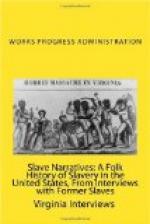“As children we played around the yard; those of us who were old enough had odd jobs to do. The unceiled house that my father and mother shared with three other families was weatherboarded and had a chimney made of sticks and dirt. There was a bed in each corner of the room and from one to three children slept in the bed with their parents: the rest of the children slept on the floor. The tall old home-made wooden beds had very much the appearance of beds used now, except that cords were used instead of the metal springs that came into use later. Our osnaburg mattress ticks were filled with straw. I’m quite sure there were no pillows. There was also a two-story house on the lot for slaves.” She was asked what she called her father and mother during slavery time, and her reply was: “I have always said father and mother because I liked it better, and the Bible teaches us to say that.
“Grandmother Dilsey and grandfather Levi Crawford lived in Lexington. I saw my grandmother one time, but I don’t know what she did at the white folks’ house. Grandfather was a carpenter.
“I never got any money in slavery time. If the slaves ever got any, it was when the Yankees came through here. At that time the white people gave their money to the slaves for safekeeping, and after the Yankees went on it was returned to the white owners.
“My mother was the cook and looked after the house. Oh, yes indeed, we had good food to eat. Bread, milk, meat, collard greens, turnips, and potatoes. I would say we had just everything that was grown in the garden and on the plantations to eat at that time. The cooking was done in the kitchen in the yard. The fireplace was as wide as the end of this room, and a long iron bar extended from one end to the other. The great cooking pots were suspended over the coals from this bar by means of pot hooks. Heavy iron skillets with thick lids were much used for baking, and they had ovens of various sizes. I have seen my mother bake beautiful biscuits and cakes in those old skillets, and they were ideal for roasting meats. Mother’s batter cakes would just melt in your mouth and she could bake and fry the most delicious fish. There was no certain thing that I liked to eat more than anything else in those days. I was young and had a keen appetite for all good things. Miss Fannie and Miss Susan often made candy and it was so good I could have eaten all they made, had they given it to me. My father hired his time out; he made and sold gingercakes on the railroad.
“In the summertime we wore homespun dresses made with a full skirt gathered onto a tight-fitting waist. In the wintertime the dresses were made of checked woolen material called linsey cloth. For underwear, we wore balmoral petticoats and osnaburg drawers. We went barefooted most of the time. I remember one particular time when the ground was frozen and I went about without any shoes, but it didn’t bother me. Barefooted children seldom had bad colds in winter. We wore just anything on Sunday, but we had to look nice and clean.




